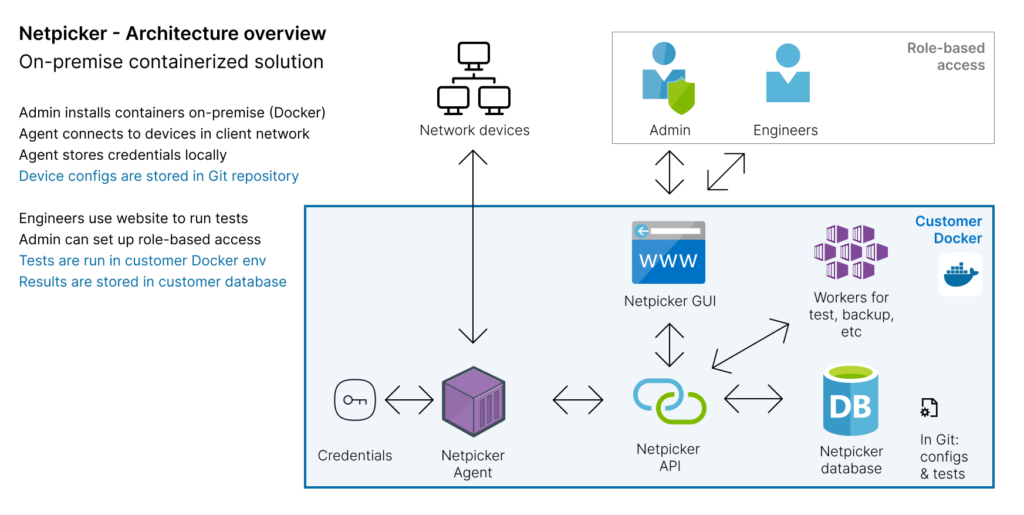
Netpicker is an on-premise containerized solution designed to automate network device configuration and testing. The architecture leverages Docker containers, role-based access, and Git repositories to manage and execute tests efficiently within a customer’s environment.
Architecture Components
1. Admin and Engineer Roles
- Admin: Responsible for installing containers on-premise, managing role-based access, and configuring agents.
- Engineers: Utilize the Netpicker web interface to run tests and analyze results.
2. Network devices
- The network devices are connected to the Netpicker agent, which facilitates communication and data exchange.
3. Netpicker agent
- A Docker container that resides within the customer’s network environment.
Responsibilities:
- Connecting to network devices to execute tests and backups.
- Storing credentials locally to ensure secure access to network devices.
4. Credentials Management
- Credentials required for network device access are securely stored by the Netpicker agent.
5. Netpicker API
- Acts as the intermediary between the Netpicker Agent and other components.
- Facilitates communication and data exchange across the system.
6. Netpicker GUI
- A web-based interface used by engineers to initiate tests, monitor processes, and view results.
- Supports role-based access control configured by the admin.
7. Customer Docker environment
- Tests and other operations are executed within the customer’s Docker environment.
- This isolation ensures that the operations do not interfere with other customer systems.
8. Workers for Test, Backup, etc.
- Multiple worker containers are deployed to handle specific tasks such as testing and backing up configurations.
- These workers are managed and coordinated by the Netpicker system.
9. Netpicker database
- Results from tests and other operations are stored in the customer’s local database.
- Ensures data privacy and compliance with customer data policies.
10. Git repository
- Device configurations and test scripts are stored in a Git repository.
- Facilitates version control and collaborative management of configurations and test cases.
Workflow
- Installation: Admin installs the Netpicker containers in the customer’s on-premise Docker environment.
- Configuration: Admin configures the Netpicker agent with necessary credentials and connects it to network devices.
- Role Setup: Admin sets up role-based access for engineers via the Netpicker GUI.
- Device Interaction: The Netpicker agent interacts with network devices using stored credentials.
- Test Execution: Engineers use the Netpicker GUI to run tests which are executed by workers in the Docker environment.
- Result Storage: Test results are stored in the Netpicker database.
- Configuration Management: Device configurations and test scripts are managed and stored in a Git repository.
Security Considerations
- Credential Storage: Credentials are stored locally by the Netpicker agent to prevent unauthorized access.
- Role-Based Access: Admins can define access levels for different engineers, ensuring only authorized personnel can perform specific actions.
- Data Privacy: All test results and configurations are stored within the customer’s infrastructure, ensuring compliance with data privacy regulations.
